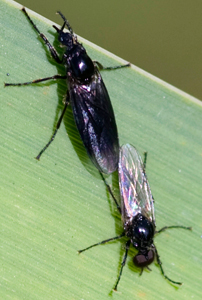Bibio marci (St Mark’s fly)
Bibio marci, St Mark’s fly, gets its name because the adults emerge around St Mark’s Day, 25th April.
Bibio marci is a large, hairy black fly that is easily recognised by the males’ ‘dancing’ up-and-down flight and long dangling legs hanging down.
Bibio marci is also the model for a fly fishing pattern, known as the hawthorn fly.
Species detail

A mating pair of Bibio marci. The female is the larger fly with smoky wings the male is smaller with clear wings. © Laurence Livermore 2009
Biblio marci species shows strong sexual dimorphism, meaning that males and females look very different.
Males
- are around 12mm long
- with very large eyes
- clear wings
Females
- are around 14mm long
- with much smaller eyes and heads
- smoky brown wings
Males use their large eyes to help them spot and catch females in the mating swarm, and to see and chase off rival males.
Adult St Mark’s flies live for about a week spending most of their lives in the larval stage. After mating females lay their eggs in the soil and die shortly afterwards.
The larvae feed and grow over the autumn and winter, emerging as adults the following spring.
-

Taxonomy
Find out about the wider families of fly to which Bibio marci belongs.
-

Biology
Male and female St Mark’s flies look very different from each other. Find out more about the sexual dimorphism of this species as well as its life expectancy and growth patterns.
-

Behaviour
Find out the months of the year when the St Mark’s fly is most commonly spotted and about the mating dance of the males.
-

Distribution and ecology
Discover the areas where the St Mark’s fly is known from, the types of habitat it is found in and learn about its feeding habits.
-

References
Get reference material for Bibio marci.
Images

Specimens of Bibio marci from the Natural History Museum’s Entomology reference collection in the Angela Marmont Centre for UK Biodiversity. © Natural History Museum 2010

A mating pair of Bibio marci - the female is to the left of the picture. © Laurence Livermore 2009

Female Bibio marci © Fritz Geller-Grim

Scottish hedgerow in early summer © Val Vannet

Male Bibio marci resting on a bluebell. © Laurence Livermore 2009

